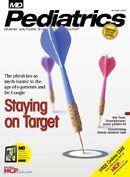Publication
Article
MDNG Pediatrics
Child Nutrition Key Focus of New Dietary Guidelines
Recent statistics on child nutrition and obesity.
Earlier this year, the US Department of Agriculture (USDA) issued the Dietary Guidelines for Americans 2010 (http://HCP.LV/h3c5jv) “to provide direction on making healthy food choices to maintain an ideal weight and improve overall health.” Children—many of whom consume diets that are too high in calories and too low in nutrients—are a particularly important focus of the guidelines. According to the USDA, approximately 32% of children and adolescents ages 2 to 19 years are overweight or obese, with 17% of children being obese. In addition, “risk factors for adult chronic diseases are increasingly found in younger ages. Eating patterns established in childhood often track into later life, making early intervention on adopting healthy nutrition and physical activity behaviors a priority.”
The report found that most American children ages 2-3 consume recommended amounts of total fruits; however, those ages four years and older fall short of recommendations. Researchers also determined that children age 2-18 years consume more than half of their fruit intake as juice. And although 100% fruit juice can be part of a healthful diet, it lacks dietary fiber, and when consumed in excess, it can contribute extra calories. The majority of the fruit recommended should come from whole fruits, including fresh, canned, frozen, and dried forms, rather than from juice.
Finally, it was found that most children and adolescents age 4-18 years and many children age 2-3 years are not getting the recommended amounts of milk and milk products, including fortified soy beverages. Recommended amounts are three cups per day of fat-free or low-fat milk and milk products for adults and children and adolescents age 9-18 years, 2.5 cups per day for children age 4-8 years, and two cups for children age 2-3 years.
Parental Influence on Child Nutrition Shouldn’t be Underestimated
A study of more than 5,000 children age 6-11 years found that youngsters whose parents purchase low-calorie or organic foods and don’t keep junk food at home are more likely than the average child to express a healthy attitude toward eating.
The 2010 American Kids Study (http://HCP.LV/fDherR), conducted by research firm GfK MRI, found that children whose parents teach them about nutrition labels are 47% more likely to avoid fattening foods, 37% more likely to stay away from sugary foods, and 31% more likely to play sports to stay in shape.
On the other hand, children who are given no nutritional rules are less likely to pay attention to sugar or fat content, to read nutrition labels, or play sports for exercise. Moreover, they are 68% more likely to eat whatever they want.
Surprising information? Maybe not, but still worth passing along to your patients.
Recommended Macronutrient Proportions by Age
Young children (1-3 years)
Carbohydrate: 45-65%
Protein: 5-20%
Fat: 30-40%
Older children and adolescents (4-18 years)
Carbohydrate: 45-65%
Protein: 10-30%
Fat: 25-35%
Adults (19 and older)
Carbohydrate: 45-65%
Protein: 10-35%
Fat: 20-35%
The Growing Battle with Obesity
According to the USDA Dietary Guidelines for Americans 2010
(http://HCP.LV/fDherR), obesity rates in children have increased significantly during the past four de­cades. In the early 1970s, the prevalence of obesity was 5% for children age 2 to 5 years, 4% for children age 6 to 11 years, and 6% for adolescents age 12 to 19 years.
In 2007—2008, the prevalence of obesity reached 10% for children age 2 to 5 years, 20% for children aged 6 to 11 years, and 18% for adolescents aged 12 to 19 years.
Educational Resources
Visit the links below to improve your knowledge of nutrition in the pediatric setting:
• Pinpointing the Right Formula for Transitioning Infants to Solid Foods (http://HCP.LV/gHJRUQ)
• Nutrition and Digestive Health (http://HCP.LV/hXUdxF)
• Are Families Hearing the Recommendations on Optimal Feeding of Infants and Young Children? (http://HCP.LV/fp6iMg)
• Hot Topics: Pediatric Obesity (http://HCP.LV/gSXieY)
• Mayo Clinic Nutrition in Health and Disease (http://HCP.LV/mcnhd)
